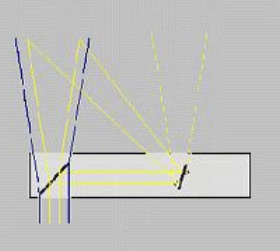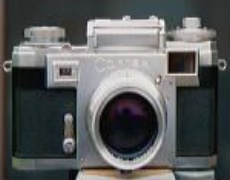
BetterPhoto Member |
|
SLR
What exactly is the difference between SLR and 35mm?
June 29, 2001
|
|
|
doug Nelson |
|
Michelle,
SLR stands for single lens reflex, a 35-mm camera design that allows you to look right through the lens when you compose your picture and focus. This design also makes interchangeable lenses easier to design and manufacture.
Most consumer cameras these days are 35 mm, but not SLR's. They have their viewfinder window above and to one side of the lens. The old term for this design is rangefinder, because you formerly had to focus using this little window.
June 29, 2001
|
|
|
Jeff S. Kennedy |
|
One minor correction to what Doug said. Most of the current point and shoot cameras do have viewfinders above and/or to one side of the lens but they are not necessarily rangefinders. Rangefinder is not the old term for this type of camera. A rangefinder is a design where the lens is coupled to the viewfinder and by means of a "ghosted" image you are able to focus. Many of today's p&s cameras are autofocus and have nothing to do with rangefinders.
June 29, 2001
|
|
|
Kris Haskins |
|
I've often wondered how the rangefinder cameras couple the lens to the viewfinder. Can anyone explain how they do it?
June 29, 2001
|
|
|
John A. Lind |
|
|
|
|
|

Rangefinder Triangulation
How a rangefinder works to show focus through a viewfinder
John A. Lind
|
|
|
|
Kris,
I believe you are familiar with the triangulation method to measure distance. If you know the length of a right triangle base and the angle between the hypotenuse and the base, you can find the length of the other leg.A rangefinder has two windows on the front, one for the viewfinder and the other (typically smaller with a green or yellow filter), separated by several inches (on a camera). This is called the "base." The longer the rangefinder base, the more accurate the distance measurements. The second window provides the overlap image as a spot in the center of the viewfinder and gives a view along the triangle hypotenuse. Its image is reflected over to the viewfinder via a rotating mirror or prism. The viewfinder has a fixed, partially silvered mirror or another prism to superimpose the two images. For those RF's bodies with interchangeable lenses, the focus helical is typically on the camera body, not the lens. As you focus the lens, the rotating mirror (prism) rotates changing the view provided for it. Most have a "focusing wheel" and all have a precision gear train between the rotating mirror (prism) and the lens focusing helical. When the focus wheel is turned, both the lens helical and rotating RF mirror turn simultaneously. Obviously, the rotating RF mirror (prism) and focus helical alignment is critical. Usually they are set at infinity. The helical is adjusted for infinity position by mounting the camera without its back and using a piece of frosted glass over the film gate (frosted part facing forward toward the lens). The camera is aimed at an extremely distant object and the helical adjusted for critical infinity focus on the ground glass viewed using a high power loupe (much as you would do on a view camera ground glass). Then the overlapping image in the RF is adjusted so that it aligns properly. I've uploaded a small diagram showing how the triangulation works between the the viewfinder window and rangefinder windows. -- John
June 30, 2001
|
|
|
John A. Lind |
|
Another image to show what a typical rangefinder viewfinder shows. The center yellow rectangle is from the RF window and is superimposed over the viewfinder image. When out of focus, you will see "ghost" image superimposed. When focused, the "ghost" image (in this case tinted yellow) aligns with the viewfinder one.
June 30, 2001
|
|
|
John A. Lind |
|
|
|
|
|

A Rangefinder's Viewfinder
The rangefinder window superimposes an image over the one in the viewfinder. When aligned, the lens is in focus.
John A. Lind
|
|
|
|
June 30, 2001
|
|
|
Kris Haskins |
|
Thank you John.
June 30, 2001
|
|
|
John A. Lind |
|
A small photo of my Zeiss Ikon Contax IIIa (Color Dial). You can see the larger viewfinder window on the right and the smaller rangefinder window on the left. The focusing wheel is the small hump just above the rangefinder window. This is a mid-1950's RF. Some newer compact rangefinders, such as the Canonet G-III (mid-1970's), have an arm on the lens focus helical itself allowing very rapid focus by directly turning the helical. An internal geartrain from the lens focus helical rotates the mirror behind a rangefinder window. -- John
June 30, 2001
|
|
|
John A. Lind |
|
June 30, 2001
|
|
|
doug Nelson |
|
Y'all sure milked a lot of info out of my wrong answer. You made me think, too. Why would an autofocus camera need a rangefinder? Thanks.
July 02, 2001
|
|
|
John A. Lind |
|
|
|
|
|

Zeiss Ikon Contax IIIa CD Rangefinder
Larger window on the right is viewfinder. Smaller window on left is rangefinder and small hump just above it is the focusing wheel.
John A. Lind
|
|
|
|
Yet another try at the Contax IIIa image upload.
July 02, 2001
|
|
|
|
Log in to respond or ask your own question.
|